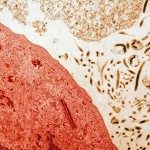Lien vers Pubmed [PMID] – 28957419
PLoS Pathog. 2017 09;13(9):e1006610
IFITMs are broad antiviral factors that block incoming virions in endosomal vesicles, protecting target cells from infection. In the case of HIV-1, we and others reported the existence of an additional antiviral mechanism through which IFITMs lead to the production of virions of reduced infectivity. However, whether this second mechanism of inhibition is unique to HIV or extends to other viruses is currently unknown. To address this question, we have analyzed the susceptibility of a broad spectrum of viruses to the negative imprinting of the virion particles infectivity by IFITMs. The results we have gathered indicate that this second antiviral property of IFITMs extends well beyond HIV and we were able to identify viruses susceptible to the three IFITMs altogether (HIV-1, SIV, MLV, MPMV, VSV, MeV, EBOV, WNV), as well as viruses that displayed a member-specific susceptibility (EBV, DUGV), or were resistant to all IFITMs (HCV, RVFV, MOPV, AAV). The swapping of genetic elements between resistant and susceptible viruses allowed us to point to specificities in the viral mode of assembly, rather than glycoproteins as dominant factors of susceptibility. However, we also show that, contrarily to X4-, R5-tropic HIV-1 envelopes confer resistance against IFITM3, suggesting that viral receptors add an additional layer of complexity in the IFITMs-HIV interplay. Lastly, we show that the overall antiviral effects ascribed to IFITMs during spreading infections, are the result of a bimodal inhibition in which IFITMs act both by protecting target cells from incoming viruses and in driving the production of virions of reduced infectivity. Overall, our study reports for the first time that the negative imprinting of the virion particles infectivity is a conserved antiviral property of IFITMs and establishes IFITMs as a paradigm of restriction factor capable of interfering with two distinct phases of a virus life cycle.

